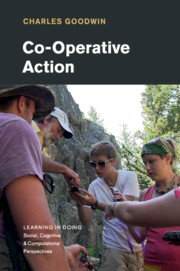Book contents
- Co-Operative Action
- Learning in Doing: Social, Cognitive and Computational Perspectives
- Co-Operative Action
- Copyright page
- Dedication
- Contents
- Figures
- Acknowledgments
- 1 What Is Co-Operative Action, and Why Is It Important?
- Part I Co-Operative Accumulative Action
- 2 Co-Operative Accumulation as a Pervasive Feature of the Organization of Action
- 3 The Co-Operative Organization of Emerging Action
- 4 Chil and His Resources
- 5 Building Complex Meaning and Action with a Three-Word Vocabulary
- 6 The Distributed Speaker
- Part II Intertwined Semiosis
- Part III Embodied Interaction
- Part IV Co-Operative Action with Predecessors
- Part V Professional Vision, Transforming Sensory Experience into Types, and the Creation of Competent Inhabitants
- References Cited
- Index
- Series page
4 - Chil and His Resources
from Part I - Co-Operative Accumulative Action
Published online by Cambridge University Press: 03 November 2017
- Co-Operative Action
- Learning in Doing: Social, Cognitive and Computational Perspectives
- Co-Operative Action
- Copyright page
- Dedication
- Contents
- Figures
- Acknowledgments
- 1 What Is Co-Operative Action, and Why Is It Important?
- Part I Co-Operative Accumulative Action
- 2 Co-Operative Accumulation as a Pervasive Feature of the Organization of Action
- 3 The Co-Operative Organization of Emerging Action
- 4 Chil and His Resources
- 5 Building Complex Meaning and Action with a Three-Word Vocabulary
- 6 The Distributed Speaker
- Part II Intertwined Semiosis
- Part III Embodied Interaction
- Part IV Co-Operative Action with Predecessors
- Part V Professional Vision, Transforming Sensory Experience into Types, and the Creation of Competent Inhabitants
- References Cited
- Index
- Series page
Summary
A blood clot that formed in the left hemisphere of Chil’s brain left him with a three-word vocabulary: Yes, No, and And. Despite this he remained for the rest of his life a powerful actor and indeed speaker, someone who could not only engage in rapid face-to-face interaction, but also carry on conversations on the phone. Subsequent chapters will investigate in detail how this was possible. The current chapter describes his repertoire of resources, which included not only his impoverished vocabulary, but also rich prosody, gesture, the ability to understand what others were saying, and fluent timing. His success as a speaker despite an almost-complete inability to produce sentences, or indeed complex syntax of any kind, demonstrates the central importance of the construction of utterances and action through co-operative action investigated in earlier chapters. Simultaneously it calls into question the unproblematic identification of the category speaker with the ability of an individual (rather than a distributed multiparty system organized through co-operative action) to produce complex language structure. My practices for videotaping his daily life over a period of eight years are briefly described.
* * *
- Type
- Chapter
- Information
- Co-Operative Action , pp. 59 - 67Publisher: Cambridge University PressPrint publication year: 2017

